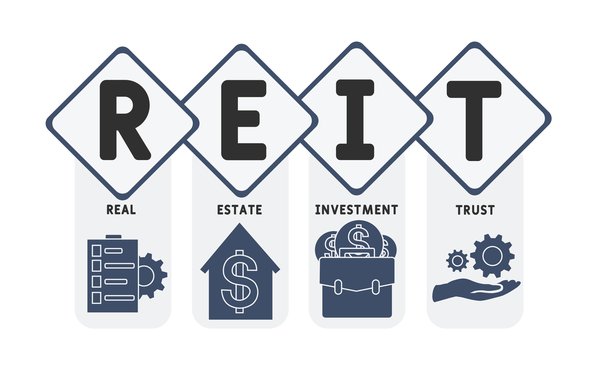Congress created real estate investment trusts (REITs) so that anyone could invest in real estate. The structure leveled the playing field that was once only available to those with a high net worth. Today, anyone with an online brokerage account and some spare cash can invest in REITs with just a few clicks.
Overall, REITs have been a good investment throughout the years. Here's a closer look at why investors should consider adding REITs to their portfolios.
Why invest in REITs?
Why REITs make a good investment
REITs offer investors several benefits that make them an ideal fit in any investment portfolio. These include competitive long-term performance, attractive income, liquidity, transparency, and diversification.
Competitive long-term performance
Historically, REITs have performed well compared to stocks, especially over long periods. For example, over the last 45 years, REITs, as measured by the FTSE Nareit Composite Index, have produced a compound annual average total return (stock price appreciation and dividend income) of 11.4%. That's only slightly less than the S&P 500's return of 11.5% per year during that period.
REITs have outperformed stocks during some periods. For example, they've outperformed small-cap stocks as measured by the Russell 2000 Index in the last 3-, 5-, 10-, 15-, 20-, 25-, 30-, 35-, and 40-year periods. The only period small-cap stocks outpaced REITs was over the past year. Meanwhile, REITs have outperformed large-cap stocks (the Russell 1000 Index) over the last 20-, 25-, and 30-year periods. Finally, they've outpaced bonds in every historical period over the previous 40 years.
Attractive income
One reason REITs have generated solid total returns over the long term is that most pay attractive dividends. For example, as of mid-2021, the average REIT yielded over 3%, more than double the dividend yield of stocks in the S&P 500. That income adds up over time as it makes up the bulk of a REIT's total return over the long term.
REITs pay attractive dividends because they must distribute 90% of their taxable income to remain compliant with IRS regulations. However, most REITs pay out more than 90% of their taxable income because their cash flows, as measured by funds from operations (FFO), are often much higher than net income because REITs tend to record large amounts of depreciation each year.
Many REITs have excellent track records of steadily increasing their dividends. For example, Federal Realty Investment Trust delivered its 53rd consecutive annual dividend increase in 2021, the longest in the REIT industry. Many other REITs have lengthy streaks of increasing their dividends at least once each year.
Liquidity
Real estate is an illiquid investment, meaning an investor can't readily convert it to cash. For example, suppose an owner of a single-family rental (SFR) property needed to sell to cover a big expanse. In that case, they'd have to list the property, wait for an acceptable offer, and hope they don't run into any snags leading up to closing. It could take months before they're able to convert the property into cash, depending on market conditions. They'd also likely need to pay a real estate agent fee as well as other closing costs.
On the other hand, if a REIT investor needed money, they could log on to their online brokerage account and sell REIT shares anytime the market is open. A REIT investor also wouldn't pay any fees to sell since most brokers don't charge commissions.
Transparency
Many private real estate investments operate with little oversight. Because of that, real estate sponsors can make decisions that aren't always in the best interest of their investors.
However, REITs are highly transparent. Independent directors, analysts, auditors, and the financial media all monitor REITs' performance. They're also required to report their financial results to the SEC. This oversight gives REIT investors a level of protection so management teams can't easily take advantage of them for their gain.
Diversification
REITs enable investors to diversify their portfolios across the commercial real estate market, helping reduce their correlation to the stock and bond markets. That diversification helps lower an investor's risk profile without negatively impacting returns.
For example, a traditionally balanced portfolio of 60% stocks and 40% bonds has historically produced a slightly more than 7.8% return over the past 20 years, with a Sharpe Ratio of 0.27 and a standard deviation of 10. The Sharpe Ratio measures risk compared to a risk-free investment like a U.S. treasury bond, with a greater value implying a more attractive risk-adjusted return. Meanwhile, the standard deviation is a statistical measure of volatility, with a higher number indicating a more volatile investment. For comparison's sake, a more aggressive approach -- 80% stocks and 20% bonds -- has historically returned roughly 8.3% but with a 0.17 Sharpe Ratio and a standard deviation above 13.
Adding REITs to a portfolio provides solid returns with less risk. For example:
- A 55% stock/35% bond/10% REIT portfolio has historically produced a roughly 8.3% annual return but with a 0.34 Sharpe Ratio and a standard deviation of around 10.5.
- A 40% stock/40% bond/20% REIT portfolio has historically produced a slightly more than 8.4% annualized return, with a 0.46 Sharpe Ratio and a standard deviation of less than 10.
- An evenly split 33.3% spread across stocks, bonds, and REITs has produced a nearly 9% average annual rate of return, with a 0.49 Sharpe Ratio and a standard deviation of about 11.5.
Thus, adding REITs to a portfolio should enable it to produce better risk-adjusted returns as they should help smooth out volatility.
Related investing topics
Should you invest?
REITs are a good investment for any portfolio
REITs have historically produced solid returns. They also provide investors several other benefits, like dividend income and diversification. Because of that, they're a good addition to any investor's portfolio.



































